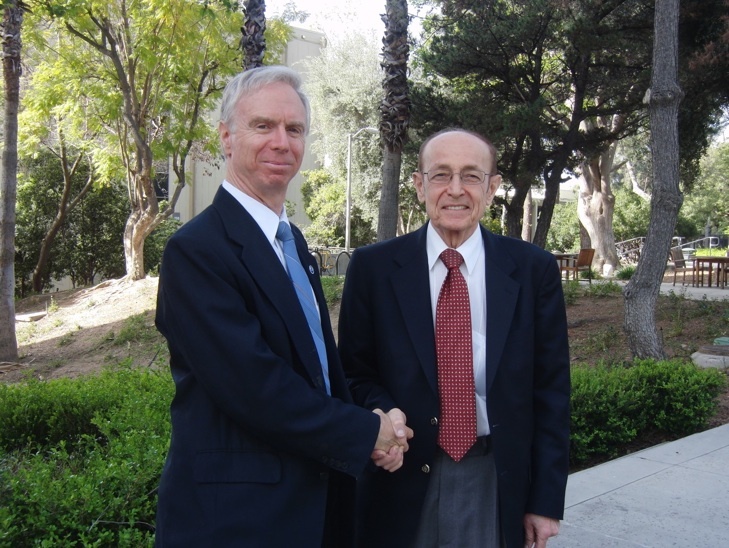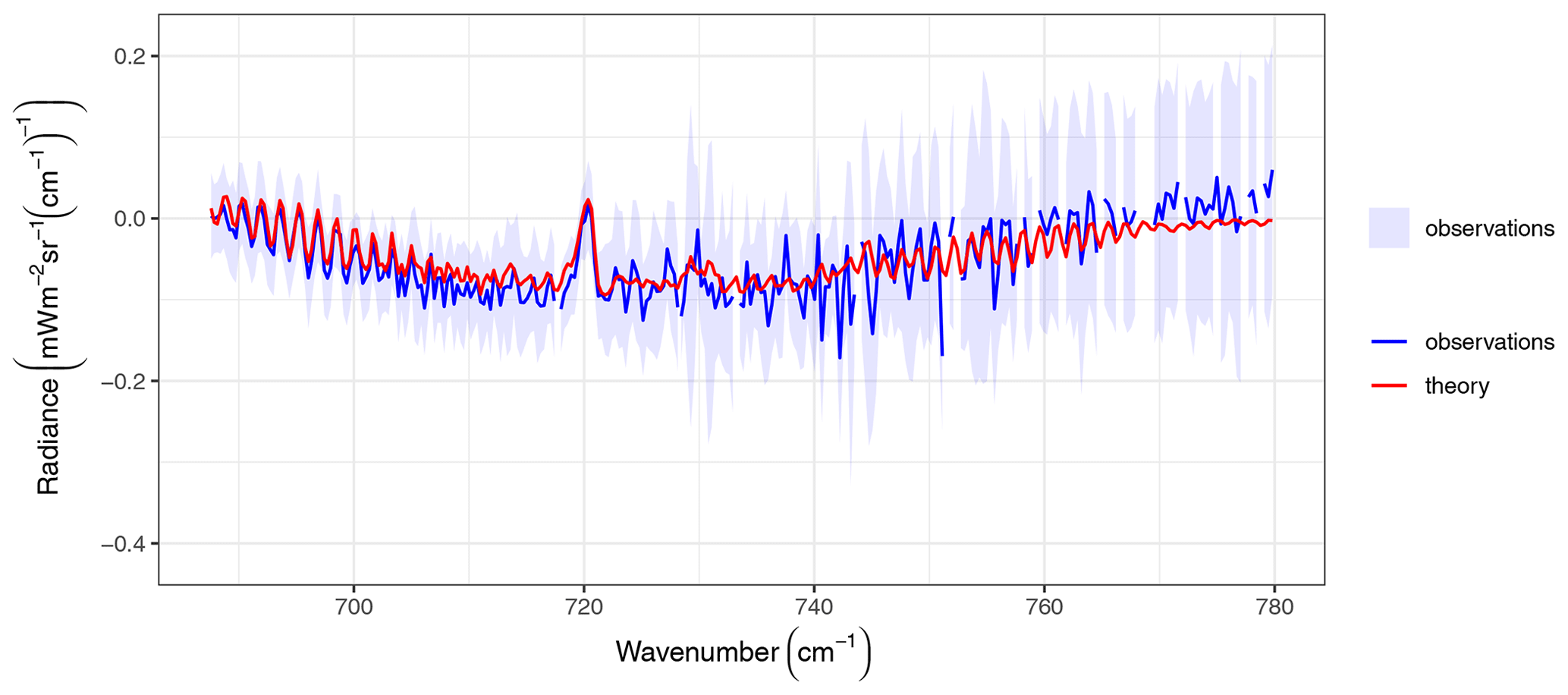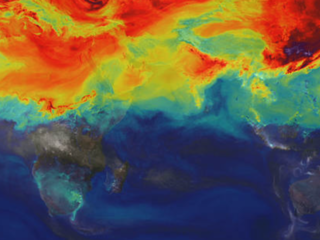News | May 10, 2011
An interview with NOAA's Dr. Bob Atlas and AIRS Science Team Leader Dr. Moustafa Chahine

Dr. Robert Atlas, Director of the National Oceanic and Atmospheric Administration's Atlantic Oceanographic and Meteorological Laboratory and AIRS Science Team Leader, Dr. Moustafa Chahine. Credit: Sharon Ray
By Sharon Ray, NASA Jet Propulsion Laboratory
Moustafa Chahine, or "Mous" as he was called by friends and colleagues, was awarded the Outstanding Presentation Award by the Program Chairs of the 15th Conference on IOAS-AOLS for his presentation "AIRS near-surface atmospheric CO2 for modeling, transports, and assimilation". Chahine made the presentation at the 91st Annual Meeting of the American Meteorological Society. In an interview on March 18th, AIRS Communcations Lead Sharon Ray recorded the exchange between Bob Atlas and Mous Chahine as the award was presented.
Atlas: This past January we had our fifteenth conference at the annual meeting, and my program co-chair Professor Kayo Ide and I were sitting in the back when you gave your presentation. We tried to sit in on all of the presentations. We were just amazed by what you were showing and how you presented it, and the thought hit both of us at that moment that this presentation needs to be recognized. In the fifteen years for the IOAS, we've never given an award for the most outstanding presentation or for any presentations, so I contacted the AMS and I said that we want to recognize this presentation as the best in our conference for this year. AMS agreed, and the result is this certificate with their logo on it.
Chahine: Thank you.
Atlas: This is the only such award that we've ever given out, and I don't know that any of the other conferences have ever given out an award for the most outstanding presentation. So it really is quite an honor.
Chahine: It's very nice. I thank you. I thank you very much.
Atlas: On a personal level, I've been involved with satellite temperature soundings since the 1970s, and we always expected that when a sounder like AIRS came along, there would be improvements to weather prediction, and we, of course, were not disappointed. There's tremendous research being done with AIRS to improve weather analysis and prediction and understanding. We never expected, at least the people I was working with, that such an outstanding CO2 product would be produced. What amazed me more than anything at your presentation were the patterns of CO2 that we're seeing, the structures in the CO2. To most people, CO2 is a line on a graph or a point on a graph, and to see this as maps with variability that relate to atmospheric processes and transport, I think it's just the kind of awe we get when we discover new things with satellite data. So, to me, this is a tremendous achievement of the AIRS team.
And the way you presented it at the conference was masterful. It was not an overwhelming "Here's the greatest stuff in the world." It's among the greatest, but it was very low key, calm and I got the feeling that everyone who was sitting there in the audience--and we had a packed room--was just totally awestruck with what you were presenting. So that's why this first award.
The fact that this has never been done in the fifteen years of the conference makes it even more significant.
Chahine: Thank you.
[applause]
[[IMAGE||/system/internal_resources/details/original/43_atlas-chahine-award.jpg||Left||300||atlas chahine award||Credit: Steve Friedman||||206||]]Yes, the accuracy of the CO2 came as a surprise to me. I knew we could get it, but I was not sure with what degree of detail and accuracy, and that really came out to be very surprising. So I'm among the first to say I did not expect this to come from AIRS, but we got it.
Atlas: This is the exciting thing in working with satellite data--
Chahine: Yes.
Atlas: --that whenever you see new things that you didn't expect or didn't know existed, to me, that's the greatest thrill of doing research with space-based observations.
Chahine: Yes. The other element here is that when we discovered this inhomogeneity and the complexity of the southern hemisphere structure that was never observed before, we did not shy away from it. We did not say we are not sure. We were sure of what we got and we stuck to it and turned out to be correct.
Atlas: Yes. Outstanding stuff.
Chahine: Thank you very much. I enjoyed coming to your meeting and giving a presentation one year after the other.
Atlas: I've been chairing the IOAS for five years. Most people serve as a program chair for one year. I've done it for five years now, and we've watched it develop as a conference. People have been telling me now it's the premier data assimilation conference.
Chahine: It is, yes.
Atlas: The fact that we bring in the observational people, both satellite in situ and the data assimilation and modeling people all together, I think is what makes it so strong.
Ray: I think it was also very interesting to learn that you have never given this award out.
Atlas: Right. I think even if we gave one of these out every year, it would still be a very significant thing. There are fantastic presentations at the conference. To be selected as the best...
Ray: This is for the overall conference?
Atlas: This is for the fifteenth. You're going to probably have to write it out or go to the AMS website. It's the fifteenth IOAS-AOLS conference, and let me say what all those mean. Integrated Observing and Assimilation Systems. For the Atmosphere, Ocean, and Land Surface. That's a mouthful. So is AMOL.
Chahine: Yes, right
Atlas: So the fact that this has never been done in the fifteen years of the conference, that makes it even more significant.
Ray: Mous, can you give a summary of what you presented at the conference?
Chahine: I was presenting the latest results about the distribution of carbon dioxide, and the theme, really way, if CO2 were visible, what would we see if we looked up. We saw in it that the carbon dioxide is not well mixed in the atmosphere. The prevailing ideas are that it's a gas well mixed and you cannot distinguish it from the rest of the atmosphere. It is not.
A second discovery was that the southern hemisphere has a CO2 belt caused by some transport that needs to be understood. That was a discovery.
A third one was the strong interactions between the mid atmosphere and the upper atmosphere, troposphere and stratosphere. We never saw this before, and for the first time we had a global view of how the two parts of the atmosphere interact with each other. This is very important for climate. Cooling of the stratosphere means associated with warming in the troposphere. So the two parts, when we can see them at the same time, is a first of a kind, a unique thing.
Atlas: And this was what, I think, the people sitting there got, that we're looking at a major breakthrough here and that this data is really going to help us improve our understanding of the carbon cycle and is really an important element in studying climate change.
Ray: Was there anything that was truly unexpected?
Chahine: All three were unexpected, yes. Since we've never looked at carbon dioxide before globally, whatever we saw was new and unexpected.
Ray: And what is the next step?
Chahine: Oh, the next step right now is to go down near the surface, go to the lower troposphere and extract carbon dioxide in this region, which will help us understand the sources, the distribution, and the transport from the surface to the top of the atmosphere.
Atlas: I'd like to add one thing, not from the carbon dioxide perspective, but from the weather perspective. What we're hoping the next step for this kind of technology is to get an AIRS-type instrument, a hyper-spectral sounder at very high horizontal resolution down to about 1 kilometer resolution, that this would be a tremendous boon to the atmospheric science community and to weather prediction.
Ray: Mous, following up on what you said that the next step is to go down to the surface, what are the challenges? You've got CO2 in the mid-troposphere pretty well in hand. What are the challenges about going to the surface?
Chahine: How to separate the surface from the layer of air above it. The surface acts like—when you're looking at light straight, you know, into the light bulb—it's very hard to determine what's between you and that light bulb because you are saturated by the light you are getting from the source. So what we have done here is found a way to separate the two, so we can suppress the effect of the source, the surface itself. We can separate the source effect from the intervening layers above it and this way we can get the evaluations of the carbon dioxide near the surface.
Ray: So it's really an analytical challenge, right, because the data is there. You can't change anything in the instrument, so it's really about uncovering it in the data?
Chahine: What you have is a wealth of information in the spectrum of AIRS, and our role was to see what's the best way to extract this information, the carbon dioxide from the trove of information we are getting from AIRS.
Atlas: I'd like to add something. This is one of the hallmarks of the best of NASA missions, that for all of the instruments that are planned, we can foresee applications, and with the fact that NASA funds these science teams and keeps their research going after the launch enables us to get much more out of them, much more benefit to the scientific community than would otherwise be possible. So I think this is something NASA really does well, keeping these teams going, having them explore and milk everything you can out of the data, and the amazing thing is that you find something that you didn't expect and it becomes perhaps as important as what sold the instrument in the first place.
Chahine: Right.
Ray: That's absolutely key and essential in science discovery, although sometimes I've wondered if there's room for the unexpected in NASA planning.
Atlas: Well, let me just give my opinion, and then Mous can weigh in. I think the key to excellent management is to leave the door open for these opportunities. If you take a very narrow look at a new observing system or any other research line and don't allow for the possibility, then we're really shortchanging the public on their investment. By keeping the door open, by enabling the research that allows new findings like this, is where we get such tremendous advances in our science.
Chahine: Yes, this has been in the tradition of NASA. For example, we had Voyager interplanetary mission. Now it's astrophysics. It left the solar system looking at the interplanetary, beyond the planets and the rest of the universe. So NASA took a mission that was for planetary science. After a while, the information we were getting from it allowed us to apply it to something else. Likewise, AIRS was supposed to be weather, maybe hydrology, but we have managed to extract much more than this, and NASA supports us.
What we have done with AIRS is to show that this sounder is a versatile instrument. It's not only for weather; it is climate, it is composition, all three in one, and we showed how the complementary nature of the information you get from weather, climate, and composition work together.
Ray: Bob, can you tell me what the overall session was about, the overall conference, I guess?
Atlas: Well, the conference itself, we like to highlight new observing systems, new technologies, also new uses of technologies that we have, also highlighting how to best assimilate these data into models, and also we highlight experiments to assess the value of the different observing systems and also to assess the value of new ideas through simulation experiments.
Ray: About how many presentations are at the conference?
Atlas: This year we had a substantial increase in the number of presentations. In a typical year, it exceeds a hundred. There were over two hundred at this conference.
Ray: Who will use these results now, or is this just so cutting-edge that mostly just AIRS science team personnel are being able to work with it?
Chahine: Carbon dioxide is being used right now in a variety of studies. One is correlate the carbon dioxide with El Niño, La Niña. Both have a tremendous impact, El Niño in particular, on the distribution of carbon dioxide, can we see it, and we do see it.
Another one is to look at what they call the Madden-Julian oscillation. It's one of the cycles in atmospheric weather climate that has a great impact on rain, precipitation worldwide, and we are able to track it, looking at the carbon dioxide. The point here is that carbon dioxide is a conserved quantity. It's not like water vapor. It evaporates, precipitates, rains. Carbon dioxide stays as carbon dioxide, so you can track it, see where it went, and see how you can use it to understand the various cycles, weather system in the Earth atmosphere. Of course, the data we have eventually will go into a carbon dioxide transport model like the ones we have at Goddard, we have at NCAR, and see how can we predict the sources and the sinks of carbon dioxide, understand study of the carbon cycle.
Atlas: That's a perfect answer. [laughter] I can't add anything to that.
Ray: Then just the last question—is the overall goal here to help us better forecast, better predict the changing climate?
Chahine: Yes.
Atlas: Better understand.
Chahine: Understanding. Validate the qualities of the numerical models we have, how well do they work. We have now a tracer, and the tracer can tell us how things are moving. Do we see them in the model?
Atlas: In fact, this is the way we improve the models, by having detailed observations of what really exists in nature, comparing the models to these processes and features, and then improving the models to be able to represent them better. So, understanding of weather processes, understanding of climate, and using it to improve the models that we use in both monitoring and prediction.
Ray: Wonderful. Thank you both very much.






